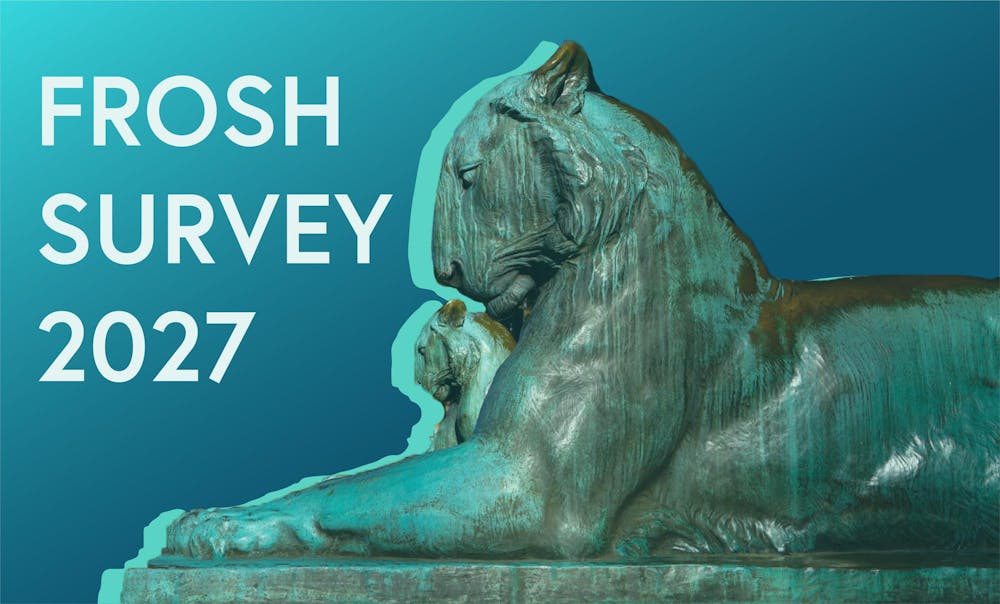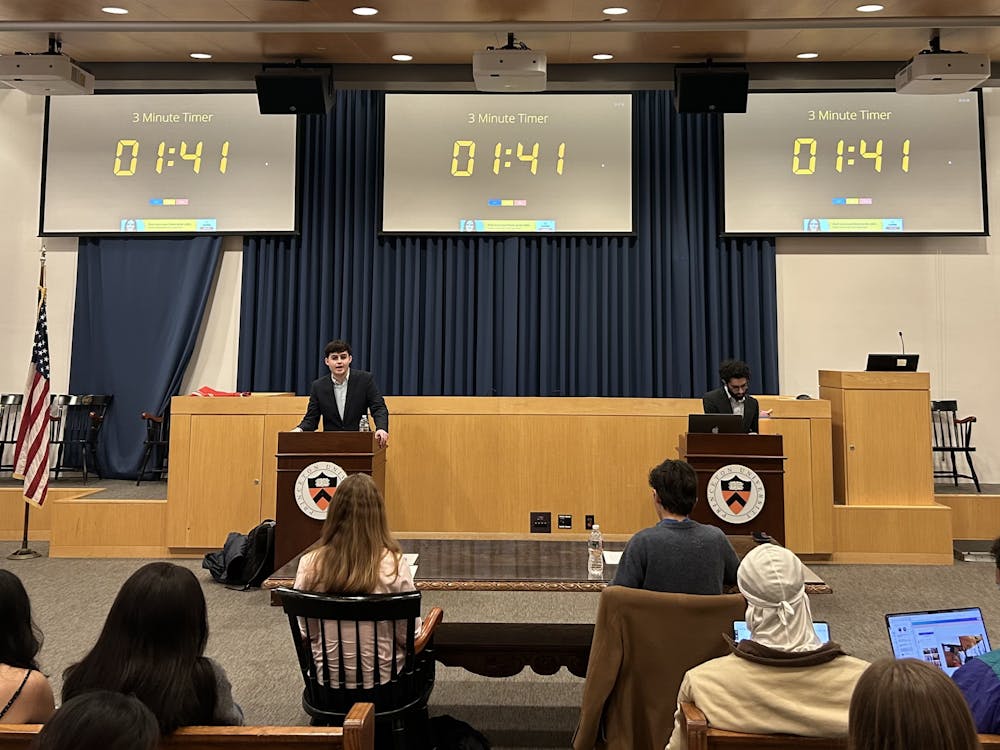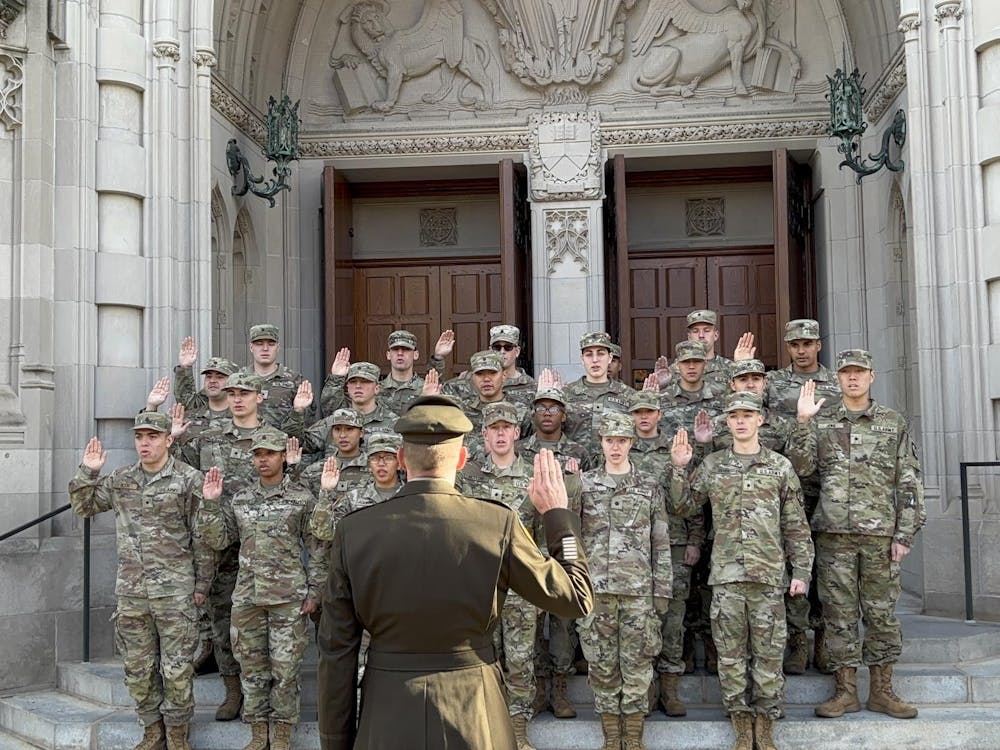Following the release of The Daily Princetonian’s fourth annual Frosh Survey, Data editors break down some interesting crosstabs.
Engineers dominated their high school clubs
By Head Data Editor Charlie Roth
The Class of 2027 entered Princeton with a phalanx of extracurricular activities. In our 2027 Frosh Survey, 805 respondents indicated being in a club in high school, with an average of 5.5 extracurricular activities per respondent. The most common extracurricular activities were Community Service (76.1 percent), Honor Societies (52.5 percent), and Varsity Athletics (also 52.5 percent).
However, disparities appeared when broken down by school type. 69.97 percent of students who went to non-selective public schools were in honor societies, compared to just 21.68 percent of independent private school students. Meanwhile, 60.62 percent of independent private school students were varsity athletes compared to 47.26 percent of non-selective public school students.
When an extracurricular activity was dominated by a certain major, it tended to be dominated by engineers. 70 percent of those who were in engineering or robotics clubs, 49 percent of the math club participants, and 49 percent of science clubs participants, were — perhaps unsurprisingly — engineers. Engineers also represented a plurality of participants in academic research, community service, honor societies, and varsity athletics.
Engineers also spent a lot of time in the clubs associated with their intended majors than others did for their intended majors. 58.5 percent of engineers who said they spent significant time on engineering or robotics clubs spent at least five hours per week in these activities. The only other group of students that spent a significant amount of time in their corresponding activity were humanities students in performing arts activities — 72.7 percent of whom spent at least 5 hours in the activity — though all respondents reported spending more time in performing arts than other activities.
Students who went to private schools also reported being in more clubs than other types of schools. Slightly over 34 percent of students who went to private schools reported being in seven or more clubs in high school, compared to just under 30 percent of students who went to non-selective public schools.

Charles Roth is a head Data editor for the Daily Princetonian.
Engineers use ChatGPT the most, least likely to view it as a "fad"
By Assistant Data Editor Suthi Navaratnam-Tomayko
Incoming first-years use ChatGPT less than peers
According to a recent Pew survey, 67 percent of U.S. adults aged 18-29 have heard either “a lot” or “a little” about the recent proliferation of ChatGPT. ChatGPT, a generative AI tool, was the fastest-growing consumer application in history as of February 2023.
According to an explainer published by IBM, “Generative AI refers to deep-learning models that can generate high-quality text, images, and other content based on the data they were trained on.” It has also been subject to controversy surrounding the ethics of its usage, specifically regarding academic honesty and ChatGPT in the classroom.
An analysis of the 2027 Frosh Survey shows incoming first-years have heard about the rise of AI models more than adults at large, with only 10.8 percent of respondents saying they “don’t know enough to say” about the rise of AI models. When asked to describe how they view the rise of ChatGPT, a plurality said they found it “useful in certain cases,” with about half as many calling it “dangerous” or “revolutionary.”
Princeton students, however, report using ChatGPT at lower rates than most Americans. According to a May 2023 study by Common Sense Media, 58 percent of students aged 12-18 have used ChatGPT, while 34.3 percent of Frosh Survey respondents have done the same. Of the students who have used ChatGPT, the most popular usages have been writing for school and administrative tasks.
According to a memo sent by Dean of the College Jill Dolan, “Just as students may not turn in someone else’s work as their own, students may not misrepresent as their own work any output generated by or derived from generative AI.”
Views and usages of ChatGPT differ by major and political views
While 38.6 percent of humanities students and 29.5 percent of social science students viewed ChatGPT as “dangerous,” only 10.8 percent of engineering students felt the same way. On the flip side, while 54.2 percent of engineering students and 52.7 percent of natural sciences students viewed ChatGPT as “useful in certain cases,” only 34.3 percent of humanities students agreed. Humanities students are also significantly more likely to view ChatGPT as a “fad” than other majors: 5.7 percent of humanities students indicated that on the survey, with only 0.8 percent of engineering students and no natural sciences and social sciences students agreeing.
Engineering students are the most likely to have used ChatGPT at all, with 44.5 percent of respondents having tried it; humanities students are the least likely to have used ChatGPT with 20.3 percent of respondents doing the same.
Students also use ChatGPT for different tasks depending on their major. Engineering students are more than twice as likely to use ChatGPT to write for school than their humanities classmates. They are also over 14 times more likely to use ChatGPT for coding as humanities students. Despite both groups being made up of STEM students, engineering students are more than twice as likely to have used ChatGPT for STEM schoolwork than their natural sciences counterparts.
Suthi Navaratnam-Tomayko is an assistant Data editor for the 'Prince.'
Non-white, conservative students perceive Princeton differently
By Associate Data Editor Ryan Konarska
With about 5,600 undergraduate students, close to 60 percent of whom belong to racial minority groups and 12 percent of whom are international, there are a wide variety of life perspectives present on Princeton’s campus. In our recent Frosh survey, we asked students to provide their demographic information along with their views of Princeton as an institution and community. For this data blog, we looked at hot-button questions surrounding Princeton’s culture surrounding wealth, free speech, and partying and how answers varied between different groups.
How white and wealthy is Princeton?
We first looked at how racial identity impacted students’ perceptions of whether Princeton was a predominantly white institution.
About 57 percent of students who were not white, or multiracial, said Princeton was a predominantly wealthy and white institution. Just a quarter of non-white students thought that Princeton was not predominantly white, while 17 percent were unsure.
On the other hand, white students expressed more mixed views on Princeton’s supposed status as a predominantly wealthy and white institution. Nearly equal numbers of white students thought Princeton was or was not predominantly wealthy and white, while about 22 percent were unsure.
Tolerant of all views, or just some?
When looking at free speech, our analysis found that more conservatives agreed with the statement that “Princeton is a place where unpopular viewpoints are shouted down.” Around 25 percent of right-wingers found this statement to be somewhat or very true, while just about 12 percent of left-leaning students thought the same.
Similar numbers of progressives and conservatives expressed uncertainty with the statement. Majorities of both conservatives and progressives said Princeton was not a place where unpopular viewpoints were shouted down.
Conservatives may be more inclined to agree with this statement given their disadvantage in numbers on Princeton’s campus. In our survey, 523 respondents identified themselves as somewhat or very left-leaning, while just 71 said they were somewhat or very right-leaning.
Is Princeton a party school?
How does legacy status affect one’s perception of Princeton’s status as a “party school?” We looked at whether one’s parents attended Princeton in relation to respondents’ views on the statement “Princeton is a place where people are always partying.”
Less than 10 percent of students who stated that any family members had attended Princeton agreed with this statement, with over two-thirds saying Princeton was not a party school. About 23 percent of legacy respondents were unsure.
Non-legacies gave similar answers to this question, with about seven percent agreeing that Princeton was a place where people are always partying, with over 70 percent disagreeing. While a slightly higher proportion of legacy students said Princeton was a party school, potential exposure to Reunions seemed to have little impact on students’ perception of Princeton’s rowdiness.
Ryan Konarska is an associate Data editor and staff News writer for the ‘Prince.’
Energy drinks on the rise among the Class of 2027
By Assistant Data Editor Andrew Bosworth
The ‘Prince’ asked incoming first-year students the question, “How often do you consume energy drinks?” in both the 2027 and 2026 frosh surveys. The results show a higher percentage of respondents regularly consume energy drinks in the Class of 2027 compared to the Class of 2026. We also looked at this in relationship with the number of AP tests respondents took.
Overall, the Class of 2027 drinks more energy drinks than their older counterparts — who are more likely to consume coffee on a daily basis.
While more members of the Class of 2027 consume energy drinks compared to the Class of 2026, 72.8 percent of incoming first years had never consumed an energy drink or consumed them less than once a semester. This is a similar percentage to those in the Class of 2026 – 72.5 percent —meaning those in the Class of 2027 who do consume energy drinks are doing so more frequently.
2.76 percent of the Class of 2027 respondents reported consuming energy drinks daily, while 1.6 percent of the Class of 2026 respondents indicated the same, meaning that the Class of 2027 reported consuming energy drinks daily at a rate 1.7 times higher than the Class of 2026. The percentage reporting consumption more than twice a week is also 1.4 times higher for the Class of 2027 compared to the Class of 2026.
Overall, percentages of those who have never consumed or hardly consume energy drinks are similar between the classes. Coffee consumption is also similar between the two classes, with 25 to 30 percent of respondents drinking coffee daily or more than twice a week.
Many consuming energy drinks in college do so for athletic or academic reasons, and are less concerned with the negative long-term effects of consumption, focusing instead on the improved alertness and physical endurance.
The ‘Prince’ broke down weekly hours studying and AP tests to determine which study and class habits lead to highest energy drink consumption.
Among those who took 13–14 AP tests, 7.7 percent consumed energy drinks daily, the highest of any AP test category. Respondents who took 3–4 AP tests have the second highest percentage of daily energy drink consumption. Interestingly, those who only took 11–12 exams had the lowest rates of consumption, with 69.6 percent having never consumed an energy drink. Respondents who took 1–2 exams had the highest rate of energy drink consumption overall with only 40.8 have never consumed a drink. While daily consumption increases with the number of exams taken, overall consumption decreases.
The comparisons between the Class of 2027 and the Class of 2026 correspond to national energy drink consumption trends. The energy drink industry is expected to increase by 7.3 percent per year until 2030. Before coming to college, a high percentage, 60.8 percent, of Princeton first-year students had never consumed energy drinks compared to national averages for high school students of around 40 percent of adolescents not having consumed energy drinks.
Andrew Bosworth is an assistant Data editor for the ‘Prince.’
Students interested in technology careers are some of least likely to consider Princeton as their top choice
By Head Data Editor Elaine Huang
In both the 2026 and 2027 Frosh Surveys, ‘Prince’ asked the question to all respondents, “If Princeton was not your top choice, which school was your top choice?” The 2026 survey results showed that 22.6 percent of respondents said Massachusetts Institute of Technology (MIT), 20.0 percent said Stanford, 17.0 percent said Harvard University, and 13.6 percent said Yale University. The fifth most popular top choice was Brown University, with 6.0 percent of responses.
In the 2027 Frosh Survey, MIT maintained its top spot, though with a slightly smaller 18.9 percent of respondents selecting the institution. Yale rose to second place, with 15.7 percent of responses, followed by Stanford with 15.0 percent and Harvard with 12.6 percent. Brown remained in fifth place with 7.1 percent.
However, despite this high interest in MIT, only 1.0 percent of survey respondents were offered admission to MIT.
The career fields with the highest percentage of respondents ranking Princeton as their top choice were “unsure” (100 percent), sports (88 percent), government/politics (79 percent), law (78 percent), and finance (76 percent).
On the other end of the spectrum, the career fields with the lowest percentage of respondents ranking Princeton as their top choice were military (0 percent), “I do not intend to work” (50 percent), technology (64 percent), entertainment (65 percent), and engineering (67 percent).
Princeton does not have a business school, law school, or medical school. However, this has not deterred many incoming first-years interested in law and finance from ranking Princeton as their top choice. 73 percent of those interested in medicine ranked Princeton first, in line with the overall statistic of 72.9 percent of all survey respondents ranking Princeton as their top choice.
According to U.S. News’ Best Undergraduate Engineering Program Rankings, MIT is ranked No. 1 while Princeton is ranked No. 12, out of schools who offer engineering degrees up to a doctorate. However, an article from The Wall Street Journal ranked the top 20 private colleges for engineering salaries, with Harvard in the top spot ($130,119 average yearly salary), Princeton at No. 4 ($114,169), and MIT at No. 7 ($109, 750).
Elaine Huang is a head Data editor for ‘Prince.’








